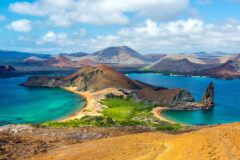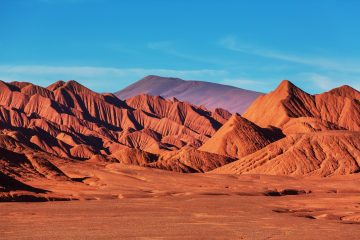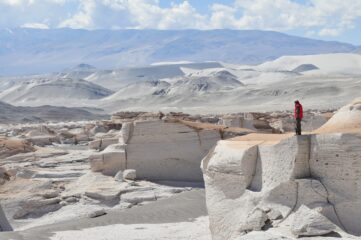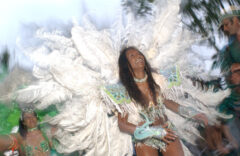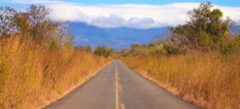Overview
Spiritually and culturally closer to Peru and Bolivia than the rest of Argentina, the remote northwest provinces offer lots of attractions for visitors. These range from snow-dotted peaks and arid, rust-red canyons to lush forests, pre-Columbian ruins, lonely, lime-washed chapels, and baroque colonial towns. Sunlit slopes are cloaked with vineyards, and you’ll find a warm welcome from the local people everywhere.
At 1,200m above sea level, Salta city is a delightful base for exploration of the region with a sumptuous cathedral, palm-shaded plazas and a cable car lift that rewards with views over the fertile countryside. Beyond Salta, high in the rarefied air of the Atacama desert, is the puna – an extraordinary landscape of yawning pearl-white salt flats, flanked by bald ochre mountains, lunar-like fields of pumice and high, undulating sand dunes.
There are a few flamingo-dotted lakes, but apart from those and a few ex-mining settlements, there’s little evidence of life. It’s blissfully peaceful and otherworldly, and you can explore it by 4WD along concealed tracks that wind through the wilderness.
Why visit Salta
Known as Salta la Linda (Salta the Beautiful), this region offers a gateway to some of South America’s most extraordinary landscapes. The city itself preserves exceptional colonial architecture, while the surrounding region encompasses everything from high-altitude deserts to subtropical yungas forests. Salta province is where Argentina’s indigenous heritage remains most visible, with traditional communities maintaining centuries-old customs alongside Spanish colonial influences.
The region’s diversity extends from the wine valleys around Cafayate to the towering formations of the Quebrada de las Conchas, and from the perfectly preserved bodies of the Children of Llullaillaco to the engineering marvel of the Viaducto La Polvorilla. Whether you’re drawn by history, adventure, great food or breathtaking scenery, Salta rewards those who travel into Argentina’s northwest.
Exploring Salta city
The capital of Salta province sits at the foot of the Andes, its centre a beautifully preserved collection of colonial buildings arranged around Plaza 9 de Julio. The neoclassical Salta Cathedral dominates one side of the plaza, its pink facade concealing an ornate interior of gold leaf and painted ceilings.
A few blocks away, Iglesia San Francisco stands out with its elaborate terracotta and yellow facade, considered one of Argentina’s finest examples of colonial religious architecture. The attached tower, soaring over the city, can be climbed for panoramic views.
For those interested in the region’s pre-Columbian past, MAAM (Museo de Arqueología de Alta Montaña) is essential. This famous museum exhibits the Children of Llullaillaco, three perfectly preserved Inca mummies discovered in 1999 at 6,739m on the Llullaillaco volcano. One child is displayed at a time in carefully controlled conditions. The exhibition provides moving insights into Inca ritual practices and high-altitude archaeology.
Other museums worth exploring include the History Museum of the North and the Museum of Fine Arts. For a break from museums, wander through Parque San Martín, the city’s largest green space with a lake, gardens and the base station for the cable car to Cerro San Bernardo.
Cerro San Bernardo
The hill rising behind the city offers spectacular views across Salta and the Lerma Valley. You can take the cable car from Parque San Martín or walk the steep trail in about an hour. At the summit, restaurants and craft stalls make it worth lingering to watch the sunset paint the mountains.
Eating out
Salta’s compact centre is easily explored on foot. The blocks around the plaza contain most hotels, restaurants and shops. For a more residential feel, San Lorenzo, about an hour from the centre, offers a cooler microclimate, hiking trails and a handful of estancias. Many visitors base themselves here for a night or two to explore the nearby cloud forest.
The city is a rising star in terms of culinary offerings. Restaurants serve traditional northwest cuisine alongside more contemporary Argentine fare, including empanadas salteñas (filled with meat and potatoes), locro (a hearty stew) and humita (corn paste steamed in husks). The peñas (folk music venues) combine dinner with live music and dancing.
Wine country: Cafayate and the Calchaquí Valleys
The journey south from Salta to Cafayate passes through the Quebrada de las Conchas, where wind and water have carved incredible rock formations from rust-coloured sandstone. Stop to explore El Anfiteatro, a natural amphitheatre with remarkable acoustics, and Garganta del Diablo, a narrow gorge cutting through towering cliffs.
Cafayate itself sits at around 1,680m above sea level in the Calchaquí Valley, one of the world’s highest wine regions. The area’s signature grape is Torrontés, a white variety producing aromatic, floral wines. Lots of wineries welcome visitors for tastings and tours. The town has an appealing, laid-back atmosphere, with a pretty plaza and several good restaurants.
Beyond wine, archaeological sites can be visited from Cafayate, including Quilmes across the border in Tucumán province and the ruins of a pre-Columbian settlement. The dramatically located ruins sit on a hillside with views across the valley
The altiplano: salt flats and coloured hills
North from Salta, the landscape climbs into the high desert of the puna. Day trips typically combine several highlights: the perfectly white expanse of Salinas Grandes salt flats, the rainbow-striped Cerro de los Siete Colores (Hill of Seven Colours) at Purmamarca, and traditional villages along the Quebrada de Humahuaca.
The salt flats stretch to the horizon at 3,450m above sea level. The intense white creates an alien-like landscape, best visited on sunny days when the contrast with the deep blue sky is most striking. Small pools allow for creative photographs using perspective tricks.
Purmamarca village clusters around a colonial church, its adobe houses matching the rust and ochre tones of the surrounding hills. The Cerro de los Siete Colores rises behind, its geological layers creating bands of colour from cream through red to purple. The village market sells woven goods and other handicrafts.
Further north, towns like Tilcara and Humahuaca preserve more of the region’s indigenous character. Pre-Inca fortresses (pucará) overlook the valleys, whilst village life continues much as it has for centuries.
The Train to the Clouds
The Tren a las Nubes (Train to the Clouds) ranks among the world’s highest railways, climbing to 4,220m above sea level. The journey from Salta passes through dramatic mountain scenery, crossing the Viaducto La Polvorilla, a curved viaduct spanning a deep canyon.
Originally built in the 1940s to connect Salta with Chile’s mining regions, the line remained largely unused until being restored for tourism. The experience takes a full day and includes stops for passengers to adjust to the altitude. The train operates from April to November.
Holidays to Salta
From expertly designed Private Journeys to trail-blazing Group Tours, browse our range of carefully crafted holidays.

Private Journeys
Argentina / Bolivia
Discover Bolivia and northwest Argentina
(based on two people sharing & excluding flights)

Private Journeys
Argentina / Chile
Food and wine: Vineyards of Argentina and Chile
(based on two people sharing & excluding flights)

Group - Classic
Chile / Argentina / Iguazú Falls
Gaucho: Vintage Argentina
(based on two people sharing & excluding flights)

Private Journeys
Argentina
Off the beaten track Argentina: Remote Puna adventure
(based on two people sharing & excluding flights)
Things to do in Salta
We proudly offer the widest range of activities, excursions and one-of-a-kind experiences across all our destinations, tried and tested personally by our travel experts.
Accommodation in Salta
Browse our unrivalled portfolio of accommodation. Every option has been carefully chosen by our team of travel experts, so you can rest assured that you’ll relax in utter comfort.
Where to go when - our guide to Salta

The weather in Salta is wide and varied
Salta's climate is generally pleasant year-round. Winter (June to August) brings reliably sunny days with cool nights, ideal for exploring. Temperatures are mostly comfortable, though nights at higher altitudes can be cold. Summer (December to February) sees warmer temperatures and occasional afternoon thunderstorms, with the desert landscapes turning surprisingly green.
The shoulder seasons of April-May and September-October offer excellent conditions with fewer tourists. Temperatures are pleasant and most attractions operate normally.
The region hosts numerous religious festivals. Semana Santa (Easter week) is particularly significant, with processions and traditional ceremonies. The Festival Nacional del Poncho in July celebrates indigenous textiles and crafts. During major festivals, book accommodation well in advance.
The Train to the Clouds operates April through November, when weather conditions are most reliable at high altitude.
Papagaio
Your edit for Latin American inspiration
Our exciting range of articles on Latin America explore everything from iconic destinations and lesser-known cultural gems to delicious traditional recipes. You’ll also find exclusive travel tips, first-hand client reviews and the chance to get your personal questions answered by our travel experts.
View Extraordinary Inspiration